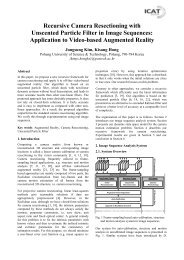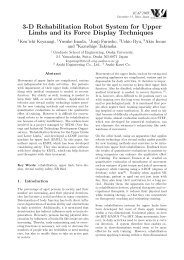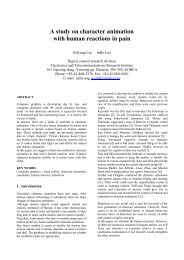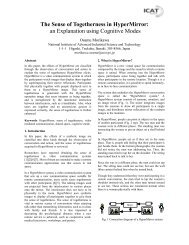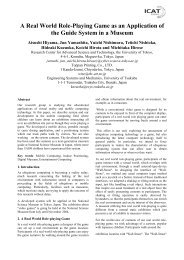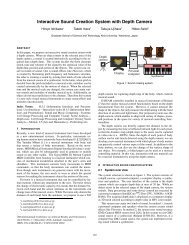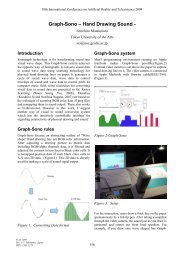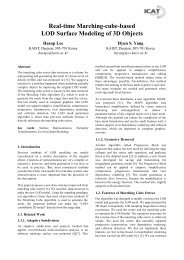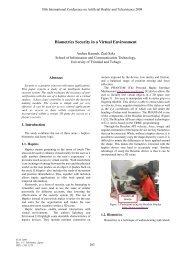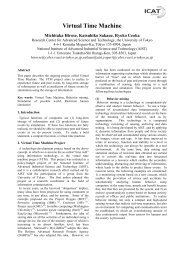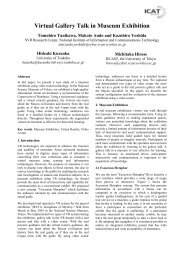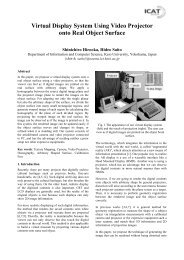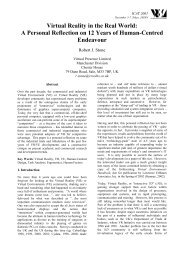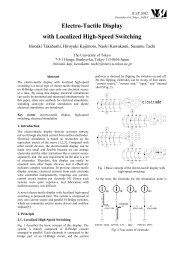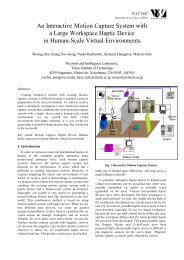Virtual Reflections for Augmented Reality Environments - VisCG ...
Virtual Reflections for Augmented Reality Environments - VisCG ...
Virtual Reflections for Augmented Reality Environments - VisCG ...
You also want an ePaper? Increase the reach of your titles
YUMPU automatically turns print PDFs into web optimized ePapers that Google loves.
<strong>Virtual</strong> <strong>Reflections</strong><br />
<strong>for</strong> <strong>Augmented</strong> <strong>Reality</strong> <strong>Environments</strong><br />
Timo Ropinski, Steffen Wachenfeld and Klaus Hinrichs<br />
Institut für In<strong>for</strong>matik, Westfälische Wilhelms-Universität Münster, Germany<br />
{ropinski, steffen.wachenfeld, khh}@math.uni-muenster.de<br />
Abstract<br />
For a photorealistic appearance of virtual objects<br />
rendered in augmented reality environments global<br />
illumination must be simulated. In this paper we present<br />
a real-time technique <strong>for</strong> generating reflections on virtual<br />
objects which are rendered into images or image<br />
sequences of real scenes. The basic idea of virtual<br />
reflections is to estimate the environment of a virtual<br />
object by extracting in<strong>for</strong>mation from the image to be<br />
augmented. Based on this estimated environment, cube<br />
map textures are generated and applied by using<br />
environment mapping during rendering to simulate<br />
reflections on the virtual object. Although some work has<br />
been done to simulate global lighting conditions in realtime<br />
augmented reality systems, current approaches do<br />
not consider reflections of real world objects onto virtual<br />
objects. <strong>Virtual</strong> reflections are an easy to implement<br />
approximation of such reflections and can be combined<br />
with existing illumination techniques, such as the<br />
creation of shadows <strong>for</strong> augmented reality environments.<br />
Key words: <strong>Augmented</strong> <strong>Reality</strong>, Environment Mapping,<br />
<strong>Virtual</strong> <strong>Reflections</strong><br />
1. Introduction<br />
The goal to generate photorealistic images when<br />
integrating virtual objects into real scenes can only be<br />
achieved if light interactions between virtual and real<br />
objects are modeled. There<strong>for</strong>e it is necessary to simulate<br />
global illumination in augmented reality environments. In<br />
this paper we present a real-time technique called virtual<br />
reflections, which is capable of simulating reflections of<br />
real world objects on virtual objects which are rendered<br />
into images or image sequences of real scenes. The<br />
proposed technique needs no additional in<strong>for</strong>mation to<br />
calculate convincing reflections when a real scene image<br />
is augmented with one or multiple virtual objects.<br />
The basic idea of virtual reflections is to estimate the<br />
environment of a virtual object by extracting in<strong>for</strong>mation<br />
from the image to be augmented. Since in most<br />
augmented reality environments (e.g., the magic book<br />
[1]) the virtual objects have to be rendered in real-time<br />
this computation has to be per<strong>for</strong>med on the fly. When<br />
using virtual reflections cube map textures are generated<br />
based on the estimated environment. These cube map<br />
textures are applied during rendering using environment<br />
mapping to simulate reflections on the virtual objects.<br />
Although some work has been done to simulate global<br />
lighting conditions in real-time augmented reality<br />
systems, current approaches ([2], [3]) do not consider<br />
reflections of real world objects onto virtual objects. The<br />
technique we are going to propose can be easily<br />
integrated into existing rendering systems supporting<br />
other illumination techniques, such as the creation of<br />
shadows in augmented reality environments.<br />
If more than one virtual object is being rendered into a<br />
virtual scene, our technique also allows the simulation of<br />
reflections of virtual objects on other virtual objects.<br />
The next section discusses related work concerning<br />
environment mapping as well as the simulation of global<br />
lighting conditions <strong>for</strong> augmented reality environments.<br />
Section 3 introduces the virtual reflections technique and<br />
explains how to improve image quality and how to<br />
simulate reflections when a real scene is augmented with<br />
multiple objects. In section 4 some examples are shown.<br />
Section 5 discusses the frame rates achieved, when<br />
virtual reflections are applied under different conditions.<br />
Section 6 concludes the paper.<br />
2. Related Work<br />
This section discusses related work regarding both, the<br />
environment mapping technique as well as the simulation<br />
of global illumination in augmented reality environments.<br />
To apply virtual reflections the construction of an<br />
environment map is necessary. Environment mapping has<br />
been introduced in 1976 by Blinn and Newell [4]. In<br />
their paper they introduce environment maps, which can<br />
be used to simulate reflections on arbitrarily shaped<br />
virtual objects. An environment map is a texture applied<br />
during rendering, which contains in<strong>for</strong>mation about the<br />
environment, i.e., the surrounding of the reflecting<br />
object. During the environment mapping process<br />
appropriate texture coordinates associated with virtual<br />
objects are used to determine, which parts of the<br />
environment are reflected on a virtual object. Greene [5]<br />
extended the technique and gave examples of two types<br />
of environment textures, spherical as well as cubic ones.
He discussed how to construct both types either<br />
synthetically or by taking a picture with a fisheye lens.<br />
Spherical environment maps provide a projection of the<br />
environment onto a sphere, while the environment is<br />
mapped onto the six sides of a cube when using cube<br />
map textures. In his paper Greene gave examples <strong>for</strong> the<br />
use of environment maps to render an infinitely far away<br />
backdrop, and to simulate realistic reflections on shiny<br />
objects closer to the virtual camera. Greene preferred the<br />
use of cubic environment maps over that of spherical<br />
ones, because of the easier integration into 3D graphics<br />
hardware. Today the environment mapping technique is<br />
accelerated by graphics hardware and is extensively used<br />
in computer games and other interactive graphics<br />
applications to simulate reflections while preserving high<br />
frame rates.<br />
Regarding augmented reality environments, some work<br />
has been done to investigate how virtual objects can be<br />
smoothly integrated into real scenes. Most of this work<br />
supporting the simulation of global lighting conditions<br />
refers to the simulation of shadowing, both shadows of<br />
virtual objects on real world objects and shadows of real<br />
world objects on virtual objects. Naemura et al. [6]<br />
describe the application of virtual lights to be placed<br />
within the environment to simulate shadows in<br />
augmented reality applications. But the technique<br />
requires in<strong>for</strong>mation about the position of the real world<br />
objects <strong>for</strong> shadow simulation. A different approach has<br />
been proposed by Loscos et al. [7]. In their work, they<br />
reconstruct the lighting in<strong>for</strong>mation of a scene as well as<br />
its geometry from a set of photographs. Since these<br />
photographs have to be taken under certain<br />
circumstances, the technique cannot be used <strong>for</strong> real-time<br />
augmentation. To allow shadows in real-time augmented<br />
reality environments, Haller et al. [3] have adapted the<br />
shadow volume technique used in real-time computer<br />
graphics. Using this technique, they are able to let virtual<br />
objects cast and receive shadows. To allow shadows as<br />
well as reflections in augmented reality environments,<br />
Debevec [8] has introduced a system classifying virtual<br />
objects with respect to their distance to the virtual<br />
camera. By only considering the objects closer to the<br />
camera a global illumination model can be used to<br />
simulate both shadows and reflections. Although only<br />
objects positioned near the virtual camera are<br />
considered, Debevec’s approach does not allow real-time<br />
augmentation. To simulate reflections in virtual reality<br />
environments, Kautz et al. [9] use cubic environment<br />
maps. In contrast to the approach presented in this paper<br />
their technique focuses on filtering techniques rather than<br />
on the construction process of the environment map. The<br />
technique is not extendable to real-time augmented<br />
reality environments, because additional in<strong>for</strong>mation is<br />
needed <strong>for</strong> generating the environment map. Agusanto et<br />
al. [2] also propose the usage of environment maps in<br />
augmented reality environments. In their approach, they<br />
improve realism <strong>for</strong> rendering virtual objects in<br />
augmented reality by using pre-filtered high-dynamic<br />
range environment maps of the real scene. Using these<br />
maps they can obtain diffuse as well as glossy light<br />
reflections on virtual objects by using a multi-pass<br />
rendering algorithm. In contrast to the technique<br />
presented in this paper, no specular reflections of real<br />
world objects are possible, since the in<strong>for</strong>mation<br />
contributing to the cube map is blurred and can be used<br />
to simulate lighting conditions only.<br />
3. Technique<br />
In this section we describe our technique to simulate<br />
reflections on virtual objects which are rendered into a<br />
real world scene. Figure 1 shows the augmentation of<br />
such a real scene image, figure 1 (a) shows a rendered<br />
3D model with textures and figure 1 (b) shows the same<br />
3D model rendered using virtual reflections.<br />
(a) no reflections<br />
(b) virtual reflections<br />
Fig. 1 3D model rendered into a real scene<br />
(model by Laurence Boissieux © INRIA 2003).<br />
3.1 Automatic Environment Map Generation<br />
<strong>Virtual</strong> reflections are achieved by applying cube map<br />
environment textures when rendering virtual objects.<br />
These cube map textures are obtained by projecting six<br />
regions L, R, T, B, X and F of the real scene image onto<br />
the six sides of a cube (see figure 2).<br />
To ensure that real world objects located on one side of<br />
the virtual object are only reflected on that particular<br />
side, the image coordinates of the virtual object have to<br />
be taken into account during generation of the cube map<br />
textures. There<strong>for</strong>e the six regions are segmented further,<br />
as is indicated by the two dashed lines in figure 2 (b).<br />
Using this segmentation the left and the right cube map<br />
texture are obtained by projecting the regions labeled<br />
with L and R onto the corresponding face of the cube,<br />
while the image in<strong>for</strong>mation above/below the dashed line<br />
is projected onto the upper/lower half of these faces. To<br />
generate the cube map textures <strong>for</strong> the top and bottom<br />
face of the cube the image in<strong>for</strong>mation of the regions T<br />
and B is used. The partition given by the dashed vertical<br />
line is used to project only parts of the image located<br />
left/right of the virtual object onto the particular half of<br />
the corresponding cube map texture.
(a) virtual reflections<br />
(b) segmentation of the<br />
scene image<br />
cube face we get visually convincing reflections<br />
especially on more complex objects or objects with<br />
curved surfaces (see section 4). Instead of cubic<br />
environment maps also spherical maps could be used.<br />
But the projection of the scene onto a spherical map<br />
would result in an unsmooth edge reaching from the<br />
map’s top to the bottom at the middle of the map’s front.<br />
Furthermore, when generating spherical maps it is much<br />
more complicated and time consuming to achieve<br />
reflections of real scene objects only onto the correct<br />
sides of virtual objects. The reason is that it would<br />
require the real-time adaptation of the spherical<br />
projection which is much more computational expensive<br />
than the adaptation of the cubic projection.<br />
(c) the generated cube map<br />
Fig. 2 Segmentation and projection of image data<br />
<strong>for</strong> the generation of the cube map.<br />
The described technique is capable of simulating glossy<br />
as well as diffuse reflections of the real scene on virtual<br />
objects. To achieve different degrees of reflection,<br />
various mechanisms can be used to combine the colors<br />
stored in the cube map textures with the virtual object’s<br />
material. We have used different combination modes<br />
provided by the OpenGL API, on which our<br />
implementation is based. In figure 1 (b) the application<br />
of the replace mode is shown, i.e., the color of the virtual<br />
object is replaced by the corresponding color stored in<br />
the cube map. This combination leads to the visually<br />
convincing representation of an object made of chrome.<br />
Figure 7 (a) shows an image applying virtual reflections<br />
using the OpenGL modulate mode. In this mode the<br />
material properties of the virtual object are multiplied by<br />
the color stored in the cube map to get the final color <strong>for</strong><br />
the virtual object.<br />
To generate the cube map texture <strong>for</strong> the back face of the<br />
cube, the inner region X of the scene image is used.<br />
Using this segmentation we are able to construct five of<br />
the six needed cube map textures. Only <strong>for</strong> the front cube<br />
map texture the in<strong>for</strong>mation is not contained in the real<br />
scene image. This texture is very important, because it is<br />
reflected by all object surfaces pointing towards the<br />
virtual camera. We approximate the in<strong>for</strong>mation needed<br />
<strong>for</strong> the front cube map texture by projecting the<br />
outermost parts of the image onto the front face.<br />
Figure 3 shows how this approximation is done by<br />
projecting the image in<strong>for</strong>mation of the four outermost<br />
trapezoidal regions (F T , F L , F R , F B ) onto four triangular<br />
areas which <strong>for</strong>m the cube’s front face (F´T, F´L, F´R,<br />
F´B). To do this we cut out a number of n triangles in the<br />
trapezoidal regions of the real scene image and use them<br />
with inverted orientation to assemble the cube map’s<br />
front face. The red gradient in figure 3 visualizes how the<br />
orientation of those image regions has been changed. The<br />
dashed lines indicate which parts of the trapezoidal<br />
regions appear on which quarter of the front texture.<br />
This way a cube map which has smooth edges between<br />
all adjacent cube faces can be constructed in real-time.<br />
Although there is a singularity in the middle of the front<br />
(a) segmentation of the<br />
scene image<br />
3.2 Improving <strong>Reflections</strong><br />
(b) cube map’s front face<br />
Fig. 3 Approximation of the cube’s front face<br />
using n=32 triangles.<br />
The constructed cube map textures always have smooth<br />
edges between all adjacent cube faces but the edges<br />
between the triangles used to compose the cube’s front<br />
map show discontinuities. The quality of the cube’s front<br />
texture and with it the reflection quality can be improved<br />
by adjusting the number n of triangles which are cut out<br />
of the outer image region and projected onto the front
(a) augmented image<br />
(b) corresponding<br />
segmentation<br />
Fig. 5 Augmentation of a real scene image<br />
with an arbitrarily placed virtual object.<br />
image border of 10-20% of the image width/height. In<br />
special cases, where the virtual object is positioned near<br />
the image border, keeping a specified minimum distance<br />
to the border can result in an area X which is smaller than<br />
the bounding box.<br />
(a) level of approximation<br />
n=32 triangles<br />
(b) level of approximation<br />
n=256 triangles<br />
Fig. 4 Comparison of scene augmentation<br />
<strong>for</strong> different levels of approximation.<br />
face. In figure 4 different levels of approximation <strong>for</strong> the<br />
cube map generation process are shown. The left column<br />
of images was created using n=32 triangles, while the<br />
right column was created using a higher approximation<br />
of n=256 triangles. From top to bottom the images show:<br />
the augmented scene, the segmentation of the real scene<br />
image and the resulting front face.<br />
To achieve the most convincing reflections it has to be<br />
considered how to divide the image into the six areas L,<br />
R, T, B, X and F. The area X which will be projected onto<br />
the cubes back face should contain image parts that lie<br />
behind the virtual object. If no extra in<strong>for</strong>mation about<br />
the scene is given, we process the bounding box of the<br />
virtual object in image coordinates (dotted line within X,<br />
see figure 3 (a)) and enlarge it to define the region X.<br />
This way X grows and moves when the virtual object is<br />
resized or moved. Experiments have shown good results<br />
using an enlargement by 5-10% of the image<br />
width/height while keeping a minimum distance to the<br />
The other regions appear optimal in most cases if F is<br />
chosen in a way that it bisects the remaining distance<br />
between X and the image border. In figure 5 an<br />
augmentation of a real scene image with an arbitrarily<br />
positioned virtual object is shown. Figure 5 (a) shows the<br />
augmented scene, while figure 5 (b) shows the used<br />
segmentation of the real scene image. The image is<br />
segmented in a way that the cube map textures are<br />
generated, such that real world objects occurring in the<br />
image will only be reflected on the corresponding sides<br />
of a virtual object. It can be seen that X is chosen in a<br />
way that the minimum distance to the bottom border of<br />
the image is kept. Results can be further improved if<br />
additional in<strong>for</strong>mation about the scene is available such<br />
as the location of walls in indoor scenes or the borders of<br />
streets in outdoor scenes. The extraction of such<br />
in<strong>for</strong>mation from the scene image could be integrated<br />
using real-time capable computer vision algorithms, e.g.,<br />
vanishing point detection.<br />
(a) recursion depth r=2 (b) recursion depth r=6<br />
Fig. 6 Multiple objects rendered into a real scene<br />
using different recursion depths.
(a) using virtual reflections<br />
(b) no reflections<br />
Fig. 7 Picture of Manhattan downtown augmented with a virtual car.<br />
3.3 Multiple Objects<br />
<strong>Virtual</strong> reflections can also be applied to a scene<br />
augmented with more than one virtual object when it is<br />
desired that the virtual objects reflect themselves on each<br />
other. These kinds of reflections can be achieved by<br />
using our technique per<strong>for</strong>ming multiple rendering<br />
passes. The number of required rendering passes depends<br />
on the number of desired recursive reflections r. Figure 6<br />
shows an example of rendering two shiny objects with<br />
virtual reflections. It as well illustrates that higher<br />
numbers of recursive reflections will only have a small<br />
impact on the resulting image.<br />
loadRealSceneImage(S);<br />
<strong>for</strong> (int r=0;r
front map can be obtained from within the picture. This<br />
segmentation used <strong>for</strong> generating the cube map textures<br />
is shown in figure 9.<br />
<strong>Virtual</strong> reflections are capable of showing<br />
approximations of the environmental reflections on<br />
virtual objects. Since the human visual perception system<br />
is not geared to distinguish physically correct reflections<br />
from approximated reflections, the user gets a convincing<br />
impression of reflections in most cases.<br />
In Figure 10 virtual reflections generated from the same<br />
environment are applied to different virtual objects.<br />
Figure 10 (a) shows virtual reflections applied to a cube,<br />
while figure 10 (b) shows reflections on a sphere and<br />
figure 10 (c) illustrates the application of virtual<br />
reflections to a teapot model. The three images illustrate<br />
that the degree of realism depends on the curvature of the<br />
object’ s surface virtual reflections are applied to. When<br />
applying the created environment map to a planar surface<br />
as one of the cube faces shown in figure 10 (a) its<br />
structure is revealed. In particular when combined with a<br />
small n denoting a low approximation level, the different<br />
parts of the cube map may be identifiable. Further the<br />
singularity at the center of the cube map’ s front face is<br />
shown when projecting on a planar surface. Similar to<br />
the cube the sphere gives a good impression of the used<br />
cube map textures, but since the sphere’ s surface is not<br />
planar the viewer may not as easily identify the<br />
reflections as fake reflections. The most convincing<br />
reflection is created on the teapot shown in figure 10 (c),<br />
which is the model with the highest degree of curvature.<br />
Figure 11 shows two more examples of the application of<br />
virtual reflections to virtual objects having a high degree<br />
of surface curvature. In Figure 11 (a) an object is<br />
rendered into an indoor scene, while in figure 11 (b) an<br />
object is rendered into an outdoor scene.<br />
5. Per<strong>for</strong>mance<br />
Fig. 8 The generated cube map.<br />
Because the cube map textures used by virtual reflections<br />
are constructed by exploiting hardware accelerated<br />
texture mapping functionality, the technique can be<br />
Fig. 9 Segmentation of the real scene image.<br />
applied in real-time.<br />
Table 1 shows frame rates measured during rendering of<br />
different objects using different levels n of<br />
approximation. Table 2 shows frame rates measured<br />
when applying virtual reflections to multiple objects. The<br />
achieved frame rates show that the level of<br />
approximation n has just a minor influence on the<br />
per<strong>for</strong>mance of the proposed technique. Furthermore the<br />
complexity of the virtual objects does not increase the<br />
overhead in rendering when using virtual reflections,<br />
because it is a single pass rendering technique and time<br />
needed <strong>for</strong> constructing the cube map textures is<br />
independent of the scene complexity.<br />
Table 1. Measured frame rates <strong>for</strong> single objects using<br />
different approximations.<br />
sphere<br />
(see figure 10 (b))<br />
teapot<br />
(see figure 10 (c))<br />
car model<br />
(see figure 7 (a))<br />
no<br />
reflections<br />
reflections<br />
(n=32)<br />
reflections<br />
(n=128)<br />
59.98 fps 59.92 fps 59.87 fps<br />
59.92 fps 59.86 fps 59.84fps<br />
8.73 fps 8.55 fps 8.55 fps<br />
Table 2. Measured frame rates <strong>for</strong> multiple objects using<br />
different approximations.<br />
sphere and torus r=2<br />
(see figure 6 (a))<br />
sphere and torus r=6<br />
(see figure 6 (b))<br />
reflections<br />
(n=32)<br />
reflections<br />
(n=128)<br />
23.26 fps 21.49 fps<br />
10.17 fps 9.98 fps
(a) cube (b) sphere (c) teapot<br />
Fig. 10 Examples showing that virtual reflections appear more realistic on objects with a higher degree of curvature.<br />
Applying virtual reflections to scenes augmented with<br />
multiple virtual objects reflecting each other results in a<br />
significant decrease of per<strong>for</strong>mance. Because the<br />
recursion depth r determines the number of needed<br />
rendering passes (see section 3.3), high values of r<br />
further decrease per<strong>for</strong>mance as it can be seen in table 2.<br />
For the per<strong>for</strong>mance tests a Pentium 4, 3 GHz system,<br />
running Windows XP Professional, equipped with 1 GB<br />
RAM and a NVidia GeForce FX5900XT graphics card<br />
with 128 MB RAM has been used.<br />
6. Conclusion<br />
In this paper we have presented a rendering technique <strong>for</strong><br />
simulating reflections in augmented reality environments.<br />
The proposed technique called virtual reflections is easy<br />
to implement and can be used in real-time augmented<br />
reality environments to generate convincing reflections<br />
on the fly <strong>for</strong> single as well as multiple virtual objects<br />
rendered into a real scene. Based on the described<br />
approach it is easy to generate cube map textures, which<br />
can be processed by current graphics systems and<br />
simulate reflections on virtual objects having materials<br />
with different degrees of reflectance.<br />
The application of virtual reflections and the possibility<br />
to combine them with existing approaches to simulate<br />
lighting and shadow casting results in an improved<br />
quality of real-time augmentation <strong>for</strong> still images as well<br />
as animations. Since virtual reflections can be applied in<br />
real-time the technique is adequate <strong>for</strong> the use in<br />
applications like the magic book [1] or augmented table<br />
environments [10], where the real world as seen by the<br />
user, usually by looking through head-mounted displays,<br />
is augmented in real-time.<br />
References<br />
1. M. Billinghurst, H. Kato, I. Poupyrev: “The Magic-<br />
Book - Moving Seamlessly between <strong>Reality</strong> and<br />
<strong>Virtual</strong>ity”. In IEEE Computer Graphics and<br />
Applications , volume 21, no. 3, pages 6-8, May 2001.<br />
2. K. Agusanto, L. Li, Z. Chuangui, N. Wan Sing, K.<br />
Chee Keong: “Photorealistic Rendering <strong>for</strong> <strong>Augmented</strong><br />
<strong>Reality</strong> Using Environment Illumination”. In IEEE and<br />
ACM International Symposium on Mixed and<br />
<strong>Augmented</strong> <strong>Reality</strong> (ISMAR03), page 208, October<br />
2003.<br />
3. M. Haller, S. Drab, W. Hartmann: “A Real-Time<br />
Approach <strong>for</strong> an <strong>Augmented</strong> <strong>Reality</strong> Application Using<br />
Shadow Volumes”. In ACM Symposium on <strong>Virtual</strong><br />
<strong>Reality</strong> Software and Technology (VRST03), pages 56-<br />
65, 2003.<br />
(a) indoor scene<br />
(b) outdoor scene<br />
4. J. F. Blinn, M. E. Newell: “Texture and Reflection in<br />
Computer Generated Images”. In Communications of the<br />
ACM, volume 19, no. 10, pages 542-547, October 1976.<br />
5. N. Greene: “Environment Mapping and Other<br />
Applications of World Projections”. In IEEE Computer<br />
Graphics and Applications, volume 6, no. 11, pages 21-<br />
29, November 1986.<br />
Fig. 11 Examples showing reflections<br />
on different 3D models.<br />
6. T. Naemura, T. Nitta, A. Mimura, H. Harashima:<br />
“<strong>Virtual</strong> Shadows in Mixed <strong>Reality</strong> Environment Using<br />
Flashlight-like Devices”. In Transactions of the <strong>Virtual</strong>
<strong>Reality</strong> Society of Japan, volume 7, no.2, pages 227–<br />
237, June 2002.<br />
7. C. Loscos, M.-C. Frasson, G. Drettakis, B. Walter, X.<br />
Granier, P. Poulin: “ Interactive <strong>Virtual</strong> Relighting and<br />
Remodeling of Real Scenes” . In D. Lischinski and G.<br />
Larson (editors), Rendering Techniques ’ 99 (Proceedings<br />
of the 10th Eurographics Workshop on Rendering),<br />
volume 10, pages 235–246, June 1999.<br />
8. P. E. Debevec: “ Rendering Synthetic Objects into Real<br />
Scenes: Bridging Traditional and Image-Based Graphics<br />
with Global Illumination and High Dynamic Range<br />
Photography” . In Proceedings of SIGGRAPH 98,<br />
Computer Graphics Proceedings, Annual Conference<br />
Series, pages 189-198, July 1998.<br />
9. J. Kautz, K. Daubert, H.-P. Seidel: “ Advanced<br />
Environment Mapping in VR Applications” . In<br />
Computers & Graphics, volume 28, no. 1, pages 99-104,<br />
February 2004.<br />
10. R. Grasset, J. D. Gascuel: “ MARE: Multiuser<br />
<strong>Augmented</strong> <strong>Reality</strong> Environment on Real Table Setup” .<br />
In ACM SIGGRAPH Conference Abstracts and<br />
Applications, 2002.



